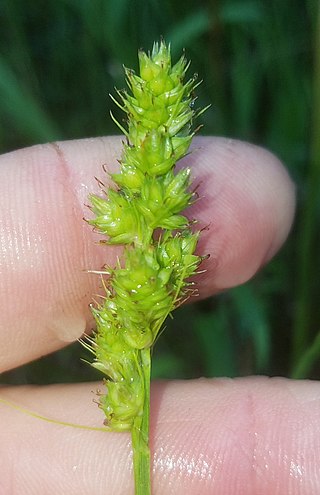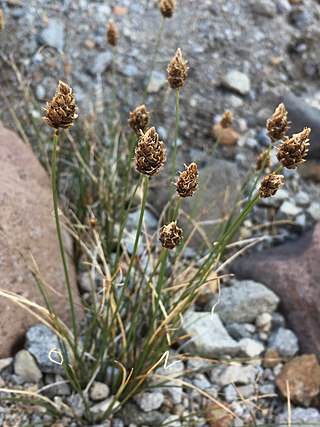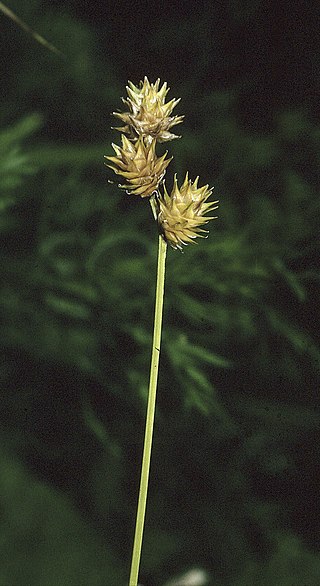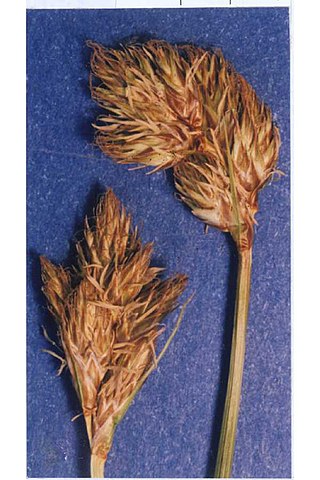
Carex jamesii, known as James's sedge or grass sedge, is a species of sedge native to North America from Minnesota east to New York and south to Oklahoma and South Carolina. It occurs in mesic hardwood forests and produces fruits from early May to mid July. It has two to four perigynia that are subtended by leaf-like pistillate scales. Its seeds are dispersed by ants.

Carex emoryi, the riverbank tussock sedge or Emory's sedge, is a species of sedge native to Canada, the United States, and the states of Chihuahua and Coahuila in northern Mexico.

Carex austrina, known as southern sedge, is a species of sedge endemic to the southern and central United States.

Carex breweri, known as Brewer's sedge, is a species of sedge that grows on dry rocky or gravel slopes in the Sierra Nevada and Cascade Mountains of the western United States, as far north as Mount Hood. It is classified in Carex sect. Inflatae, alongside Carex engelmannii and Carex subnigricans.

Carex woodii, known as pretty sedge, is a species of sedge native to North America.

Carex bicknellii, known as Bicknell's sedge and copper-shouldered oval sedge, is a species of sedge native to North America. Carex bicknellii grows in small clumps with fewer than 25 flowering stems per clump. It is found in mesic to dry prairies, savannas, and open woodlands.

Carex cristatella is a species of sedge native to eastern North America. It is an introduced species in Europe. Carex cristatella is a common species in wetlands such as swamps, marshes, shorelines, and wet prairies.

Carex sect. Phacocystis is a section of the genus Carex, containing between 70 and 90 species worldwide. With 31 species in the North American flora, sedges in Carex sect. Phacocystis commonly occur in wetlands such as shorelines, marshes, and tundra.
Carex albolutescens, known as greenish-white sedge or greenwhite sedge is a species of sedge native primarily to the lower Midwest and Eastern United States. C. albolutescens grows in wetlands, with an affinity toward acidic soils in swamps and woodlands.

Carex bebbii, Bebb's sedge, is a species of sedge native to the northern United States and Canada. Carex bebbii grows in a variety of wetland habitats such as lakeshores, streambanks, ditches, meadows, swamps, and seeps. It forms dense tufts with culms up to 90 centimeters tall.

Carex tenera, known as quill sedge, is a species of sedge native to the northern United States and Canada.

Carex brevior, known as shortbeak sedge and plains oval sedge, is a species of sedge native to North America. The specific epithet brevior means "shorter" in Latin.

Carex silicea, known as beach sedge, is a species of sedge native to North America. It is found in the northeastern United States and southeastern Canada.
Carex stenoptila, known as riverbank sedge, is a species of sedge native to North America.

Carex straminea, known as eastern straw sedge, is a species of sedge native to North America.
Carex suberecta, known as prairie straw sedge, is a species of sedge native to North America.

Carex arapahoensis, known as Arapaho sedge, is a species of sedge endemic to the western United States. It is found only in Colorado and Utah in alpine and subalpine habitat.

Carex capillaris, the hair-like sedge, is a species of sedge found in North America and northern Eurasia including Greenland.
Carex deweyanaDewey's sedge, short-scale sedge, is a species of sedge native to Canada and the United States.
Carex peckii, Peck's sedge, Peck's oak sedge, or white-tinged sedge, is a species of sedge native to Canada and the United States.














